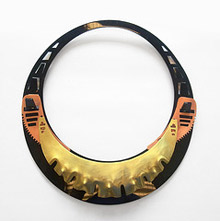More than 600 delegates assembled in the magnificent neo-gothic Wills Memorial building in Bristol where the majority of the 28 sessions took place. The session ‘Making the Bronze Age: craft and craftspeople 2500-800BC’ was held in the beautiful setting of the Old Council Chamber. Support had kindly been provided by the Prehistoric Society and the HERA-funded project Creativity and Craft Production in the Middle and Late Bronze Age (CinBA). The session organisers, Joanna Sofaer (University of Southampton) and Rob Lee (University of Southampton), brought together a diverse range of 14 speakers. Representing a wide cross-section from continental Europe and the British Isles, their papers focused on crafts and the craftsmanship of the Bronze Age, exploring a broad range of material culture, covering areas from textiles, jet, gold and amber to flint, bronze, ceramics and wood and even explored the concept of cremation as a craft. The concept of the chaîne opératoire, the social and economic context of the maker as well as conceptions and mis-conceptions of their status continuously emerged as central themes in the papers.
Joanna Sofaer opened the session and presented the paper ‘Magicians of material culture’ on behalf of Alison Sheridan of the National Museums of Scotland, who – like Eric van Rossenberg – was unable to travel to Bristol due to heavy snow. She provided an enlightening journey through the development of Bronze Age craft objects made of jet, amber, gold and faience in the light of alternative concepts such as the politics of envy and supernatural power dressing. Catherine Friedman (University of Nottingham) then took the delegates back to the production of flint daggers of the Dolktid period in 2nd millennium BC Scandinavia. She convincingly argued the case that these are extraordinary pieces of highly-specialized craftsmanship beyond being mere skeuomorphs of the copper daggers of that period. A paper by Karina Grömer and Helga Rösel-Mautendorfer (Naturhistorisches Museum Wien) continued on to give a fascinating insight into the textile finds of Hallstatt analyzing their diversity of pattern, use and origin. The first morning session was completed by Maikel Kuijpers (University of Cambridge) who set out to challenge established social concepts surrounding the early metallurgists. He argued that the question of ‘who crafts?’ can only be answered after considering the intricate social and economic webs and networks the maker was part of.

Karina Grömer giving presentation in TAG 2010, Bristol
After the coffee break (and the exciting ‘hide and seek’ for the biscuits in a separate room…), Lise Bender Jørgensen from the Norwegian University of Science and Technology examined the relationship of creativity and tradition in craft production, analyzing how craft traditions are passed on and the important role that imitation plays in the ‘apprentice/master’ relationship. Paola Bianchi from the Museo Archaeologico Nazionale di Parma then examined the organisational and social structure of Bronze Age villages in Northern Italy which revealed many artefacts and evidence of Bronze Age metal casting. Co-organizer Rob Lee then turned our attention to the craft of the Bronze Age woodworker, examining collaboration structures between different crafts in the light of complexity of various production processes. This issue of collaboration in craft production emerged again in Sophie Bergerbrant’s paper in the context of textile production.
Sarah Coxon’s (University of Southampton) ‘Creative Choices’ then brought the session to Hungary, looking at the production sequence and social changes that can be associated with the varied ceramic wares found at the tell at Százhalombatta. Staying within continental Europe, Helen Loney from the University of Worcester applied concepts and ideas surrounding Greek colonists in the Mediterranean to pottery craft in central Italy.
The last part of the session was opened by Rhiannon Pettitt (University of Manchester) who widened the definition boundaries of craft out to cremation practices, challenging our ideas of what actually constitutes craft. Following her valuable argument examining whether craft really needs a material object or not, my own paper then brought the session again to issues surrounding Bronze Age metalwork. My own focus, however was on how insights from experimental archaeology can help to develop more sustainable contemporary craft practice. The final paper by Andrew Fitzpatrick (Wessex Archaeology) brought together the subjects of funeral practices and metalwork by examining the presence of metalworker’s stone tools in Bell Beaker burials. It again posed the question which had by then emerged as one of the central questions surrounding Bronze Age craft in this session: What was the social status of craftspeople in the Bronze Age and of what value for society was their skill? The questions in the annual Antiquity Quiz – which concluded the day together with the TAG party – were certainly easier to answer…
Holger Lönze is a bronze sculptor working in West Cork, Ireland with an interest in production methods of BA horns and bronze artefacts. He is a member of the Irish experimental archaeology group Umha Aois (for more information, please visit www.umha-aois.com and www.holgerlonze.com).
This review will also be published in PAST, the newsletter of the Prehistoric Society.


 Follow us on
Follow us on 